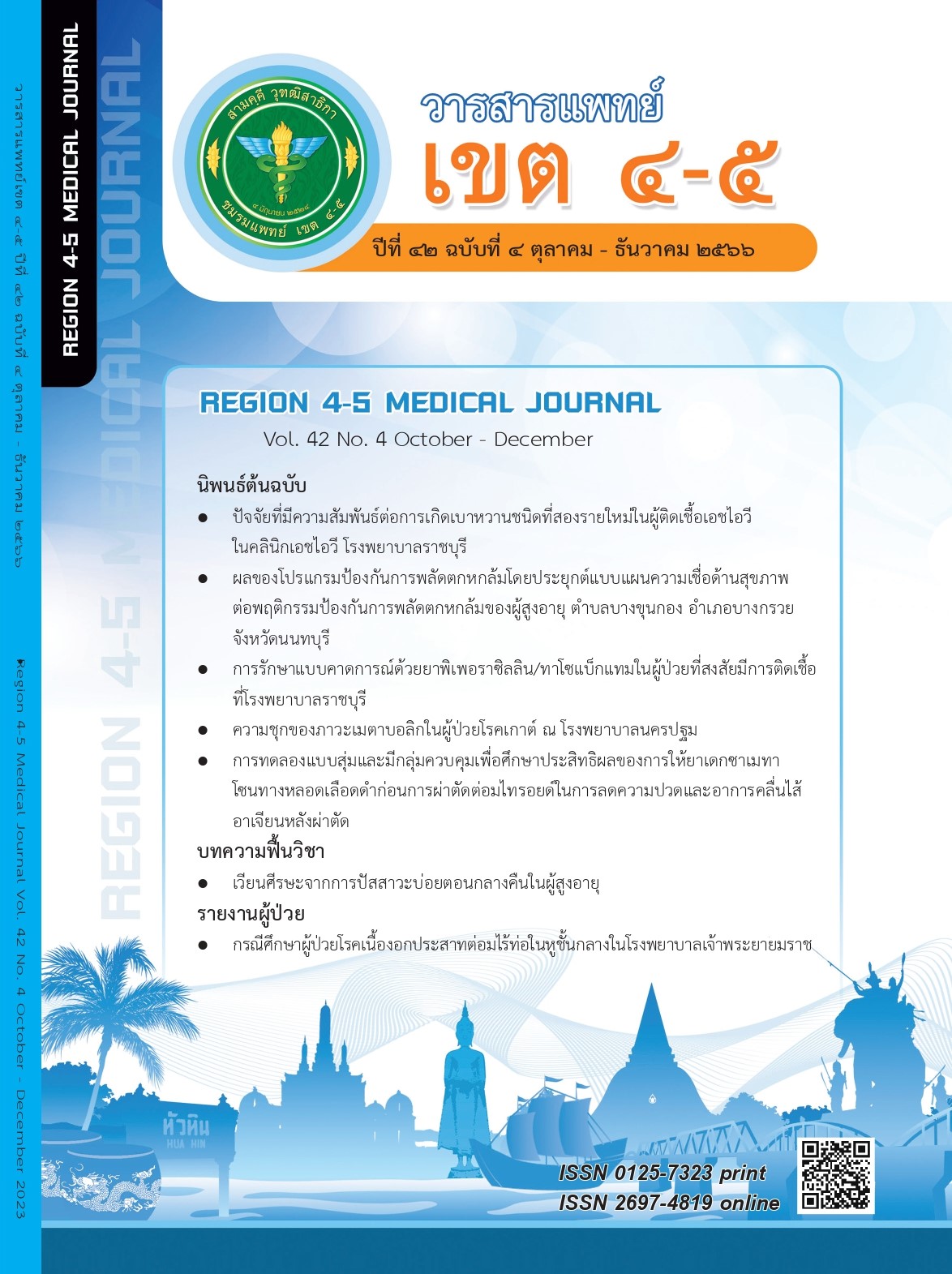ความชุกของภาวะเมตาบอลิกในผู้ป่วยโรคเกาต์ ณ โรงพยาบาลนครปฐม
คำสำคัญ:
เกาต์, เมตาบอลิก, ความชุก, กรดยูริกในเลือดสูงบทคัดย่อ
วัตถุประสงค์
- เพื่อศึกษาหาความชุกในการเกิดภาวะเมตาบอลิกในผู้ป่วยโรคเกาต์ ณ โรงพยาบาลนครปฐม
- ปัจจัยเสี่ยงของการเกิดภาวะเมตาบอลิก
- เพื่อศึกษาหาความสัมพันธ์เรื่องกรดยูริกในเลือดสูงกับการเกิดภาวะเมตาบอลิก
วิธีการศึกษา: เป็นการศึกษาย้อนหลังในผู้ป่วยโรคเกาต์ที่มีอายุมากกว่าหรือเท่ากับ 18 ปี โรงพยาบาลนครปฐม
ผลการศึกษา: เป็นการศึกษาแบบย้อนหลัง (retrospective study) ในกลุ่มผู้ป่วยโรคเกาต์ที่มีอายุมากกว่าหรือเท่ากับ 18 ปี ตั้งแต่วันที่ 23 กันยายน 2560 ถึง 23 กันยายน 2564 จำนวนผู้เข้าร่วมวิจัย/ผู้ป่วยทั้งหมด 96 คน พบภาวะเมตาบอลิก 62 คน คิดเป็นร้อยละ 64.6
วิเคราะห์ข้อมูลแบบไคสแควร์ของเพียร์สัน (Pearson’s chi-square) เรื่อง อิทธิพลระดับกรดยูริกในเลือดต่อปัจจัยภาวะเมตาบอลิก พบว่า ค่า p-value น้อยกว่า .05 คือ มีนัยสำคัญทางสถิติ ได้แก่ การสูบบุหรี่ การดื่มแอลกอฮอล์ การออกกำลังกาย และภาวะเกาต์รักษาไม่ดี (ได้แก่ ประวัติปวดข้อมากกว่าหรือเท่ากับ 3 ครั้ง/ปี การพบก้อนโทฟัส และกรดยูริกในเลือดสูง)
วิเคราะห์ข้อมูลแบบการทดถอยเชิงเส้นพหุคูณ (multiple linear regression) และพิจารณาระดับกรดยูริกในเลือด ที่ส่งผลต่อภาวะเมตาบอลิก พบว่า ระดับกรดยูริกในเลือดจะส่งผลต่อ ขนาดรอบเอว ระดับน้ำตาลในเลือด ระดับไขมันไตรกลีเซอไรด์ ระดับไขมันเอชดีแอล อย่างมีนัยสำคัญทางสถิติ ซึ่งระดับความมั่นใจร้อยละ 95 และค่า p-value น้อยกว่า .05 สำหรับระดับกรดยูริกในเลือดกับความดันโลหิตสูงตัวหน้าและตัวหลัง ไม่พบนัยสำคัญทางสถิติค่า p-value มากกว่า .05
สรุป: การศึกษานี้พบว่า ภาวะเกาต์รักษาไม่ดีและกรดยูริกในเลือดสูง สัมพันธ์กับการเกิดภาวะเมตาบอลิก การควบคุมรักษา 2 ภาวะดังกล่าว น่าจะมีประโยชน์ในการป้องกันหรือลดภาวะเมตาบอลิก
เอกสารอ้างอิง
Puig JG, Martínez MA. Hyperuricemia, gout and the metabolic syndrome. Curr Opin Rheumatol 2008;20(2):187–91. doi: 10.1097/BOR.0b013e3282f4b1ed.
Li C, Hsieh MC, Chang SJ. Metabolic syndrome, diabetes, and hyperuricemia. Curr Opin Rheumatol 2013;25(2):210–6. doi: 10.1097/BOR.0b013e32835d951e.
Lee J, Sparrow D, Vokonas PS, et al. Uric acid and coronary heart disease risk: evidence for a role of uric acid in the obesity-insulin resistance syndrome. The Normative Aging Study. Am J Epidemiol 1995;142(3):288–94. doi: 10.1093/oxfordjournals.aje.a117634.
Klemp P. Hypermobility. Ann Rheum Dis 1997;56(10):573–5. doi: 10.1136/ard.56.10.573
Abbott RD, Brand FN, Kannel, et al. Gout and coronary heart disease: The Framingham study. J Clin Epidemiol 1988;41(3):237–42. doi: 10.1016/0895-4356(88)90127-8.
ปฏิพันธ์ เสริมศักดิ์. ความชุกและปัจจัยเสี่ยงภาวะเมตาบอลิกซินโดรมของพนักงานโรงงานที่เข้ากะ ในโรงงานผลิตชิ้นส่วนอิเลคทรอนิกในจังหวัดนครราชสีมา. วารสารพยาบาลกระทรวงสาธารณสุข 2558;25(2):157–65.
Lee J, Sparrow D, Vokonas PS, et al. Uric acid and coronary heart disease risk: evidence for a role of uric acid in the obesity-insulin resistance syndrome. The Normative Aging Study. Am J Epidemiol 1995;142(3):288–94. doi: 10.1093/oxfordjournals.aje.a117634.
Muiesan ML, Agabiti-Rosei C, Paini A, et al. Uric acid and cardiovascular disease: An update. Eur Cardiol 2016;11(1):54–9. doi: 10.15420/ecr.2016:4:2.
Wang H, Zhang H, Sun L, et al. Roles of hyperuricemia in metabolic syndrome and cardiac-kidney-vascular system diseases. Am J Transl Res 2018;10(9):2749–63.
Lohsoonthorn V, Dhanamun B, Williams MA. Prevalence of hyperuricemia and its relationship with metabolic syndrome in Thai adults receiving annual health exams. Arch Med Res 2006;37(7):883–9. doi: 10.1016/j.arcmed.2006.03.008.
Choi HK, Ford ES. Prevalence of the metabolic syndrome in Individuals with hyperuricemia. Am J Med 2007;120(5):442–7. doi: 10.1016/j.amjmed.2006.06.040.
Luchsinger JA. A work in progress: the metabolic syndrome. Sci Aging Knowl Env 2006;(10):19. doi: 10.1126/sageke.2006.10.pe19.
Grundy SM, Cleeman JI, Daniels SR, et al. Diagnosis and management of the metabolic syndrome: An American Heart Association/National Heart, Lung, and Blood Institute scientific statement. Circulation 2005;112(17):2735–52. doi: 10.1161/CIRCULATIONAHA.105.169404.
Eckel RH. The metabolic syndrome. In: Fauci AS, Braunwald E, Kasper DL, et al., editors. Harrison’s principles of internal medicine. 17th ed. United States: McGrew-Hill; 2008. 1509–14.
Chen S, Wu N, Yu C, et al. Association between baseline and changes in serum uric acid and incident metabolic syndrome: a nation-wide cohort study and updated meta-analysis. Nutr Metab [Internet]. 2021;18(1):1–11. Available from: https://doi.org/10.1186/s12986-021-00584-x
Chen LY, Zhu WH, Chen ZW, et al. Relationship between hyperuricemia and metabolic syndrome. J Zhejiang Univ Sci B 2007;8(8):593–8.
You L, Liu A, Wuyun G, Wu H, Wang P. Prevalence of hyperuricemia and the relationship between serum uric acid and metabolic syndrome in the Asian Mongolian area. J Atheroscler Thromb 2014;21(4):355–65.
ดาวน์โหลด
เผยแพร่แล้ว
รูปแบบการอ้างอิง
ฉบับ
ประเภทบทความ
สัญญาอนุญาต

อนุญาตภายใต้เงื่อนไข Creative Commons Attribution-NonCommercial-NoDerivatives 4.0 International License.
ลิขสิทธิ์บทความเป็นของผู้เขียนบทความ แต่หากผลงานของท่านได้รับการพิจารณาตีพิมพ์ลงวารสารแพทย์เขต 4-5 จะคงไว้ซึ่งสิทธิ์ในการตีพิมพ์ครั้งแรกด้วยเหตุที่บทความจะปรากฎในวารสารที่เข้าถึงได้ จึงอนุญาตให้นำบทความในวารสารไปใช้ประโยชน์ได้ในเชิงวิชาการโดยจำเป็นต้องมีการอ้างอิงถึงชื่อวารสารอย่างถูกต้อง แต่ไม่อนุญาตให้นำไปใช้ในเชิงพาณิชย์




